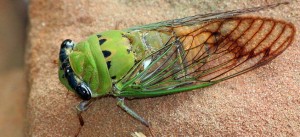Cicada
Cicada: Photo Credit: Texas Eagle
Their eyes are prominently set on the anterior lateral corners of their head (plus three additional tiny eyes between them). Their sturdy wings have conspicuous veins. Male cicadas make a loud mating sound that is not stridulation (as is produced when crickets or katydids move body parts together). Instead, male cicadas have a special modified exoskeleton on their anterior abdomen called a tymbal. Internal muscles can buckle the tymbals inwards to generate a clicking sound. When these muscles relax, the tymbals bow outward to their original position making another click. Some species of cicada can generate sounds up to 120 decibles. This sound can cause pain in the human ear; and, make it difficult for predators like birds to communicate in groups. If the sounds of the male are successful, mating will occur and the female deposits her eggs into a slit in the bark of a tree. After the eggs hatch, the nymphs fall to the ground and burrow to a depth of 1-8 feet. The nymphs live underground for most of their lives where they drink sap from roots of plants. The annual species we see and hear in Kansas trees in mid-to-late summer emerge from the ground in a year. Some emerge at the end of a seventeen-year cycle in greater numbers. In the final nymphal instar, nymphs emerge above ground, attach to a nearby plant or wooden fence post and molt (shed their skins) to become adults. Their abandoned and vacated exoskeleton remains left behind.

